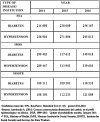Costs and epidemiological changes of chronic diseases: implications and challenges for health systems
- PMID: 25781625
- PMCID: PMC4364072
- DOI: 10.1371/journal.pone.0118611
Costs and epidemiological changes of chronic diseases: implications and challenges for health systems
Abstract
Background: The need to integrate economic and epidemiological aspects in the clinical perspective leads to a proposal for the analysis of health disparities and to an evaluation of the health services and of the new challenges which are now being faced by health system reforms in middle income countries.
Objective: To identify the epidemiological changes, the demand for health services and economic burden from chronic diseases (diabetes and hypertension) in a middle income county.
Methods: We conducted longitudinal analyses of costs and epidemiological changes for diabetes and hypertension in the Mexican health system. The study population included both the insured and uninsured populations. The cost-evaluation method was used, based on the instrumentation and consensus techniques. To estimate the epidemiological changes and financial consequences for 2014-2016, six models were constructed according to the Box-Jenkins technique, using confidence intervals of 95%, and the Box-Pierce test.
Results: Regarding epidemiological changes expected in both diseases for 2014 vs. 2016, an increase is expected, although results predict a greater increase for diabetes, 8-12% in all three studied institutions, (p < .05). Indeed, in the case of diabetes, the increase was 41469 cases for uninsured population (SSA) and 65737 for the insured population (IMSS and ISSSTE). On hypertension cases the increase was 38109 for uninsured vs 62895 for insured. Costs in US$ ranged from $699 to $748 for annual case management per patient in the case of diabetes, and from $485 to $622 in patients with hypertension. Comparing financial consequences of health services required by insured and uninsured populations, the greater increase (23%) will be for the insured population (p < .05). The financial requirements of both diseases will amount to 19.5% of the total budget for the uninsured and 12.5% for the insured population.
Conclusions: If the risk factors and the different health care models remain as they currently are, the economic impact of expected epidemiological changes on the social security system will be particularly strong. Another relevant challenge is the appearance of internal competition in the use and allocation of financial resources with programs for other chronic and infectious diseases.
Conflict of interest statement
Figures
References
-
- Cercone J (2014) Asociación público-privada para la atención a la salud. El desafío de la reforma en salud. Foro de Europa y América sobre las Reformas del Sector Salud. Banco Mundial-IESE, 2:6–11.
-
- Villarreal E, Matew-Quiroz A (2002) Costo de la atención de la hipertensión arterial y su impacto en el gasto en salud en México. Sal Pub de Mex. 2002. Vol 44, 2002 (1): 7–13. - PubMed
-
- Amos AF, McCarty D, Zimmet P (2010) The rising global burden of diabetes and its complications: estimates and projections to the year 2010. Diabetes medicine 1997; 14 Suppl 5: 51–85. - PubMed
-
- Quentin T (2013) Poverty and Policy in Latin America and the Caribbean. World Bank Technical Paper ISBN 0–8213–4754–3: 53–58.
MeSH terms
LinkOut - more resources
Full Text Sources
Other Literature Sources
Medical
Research Materials



